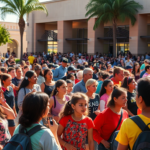Edinburg Man Sentenced for Cocaine Smuggling: A Significant Blow to Local Narcotics Trade
An Edinburg resident, Hector Julian Sustaita, has been sentenced to four years in federal prison for attempting to smuggle 43 kilograms of cocaine, with an estimated street value exceeding $3 million, into the United States. This judgment, delivered by the federal court, reflects a significant effort to curb drug trafficking through the Rio Grande Valley (RGV), impacting local communities and shedding light on broader security challenges in South Texas.
The Arrest and Sentencing
Sustaita was apprehended at the Falfurrias Border Patrol checkpoint in June 2024. While claiming to travel to Houston for work on solar panels, his story raised suspicions among authorities after a thorough inspection revealed discrepancies. With no related equipment in sight, Border Patrol agents utilized an x-ray scan and a K-9 unit, ultimately uncovering 36 bundles of cocaine hidden within various compartments of Sustaita’s Chevrolet Silverado, including the dashboard, rear door, and a secret compartment near the truck bed.
U.S. Attorney Nicholas J. Ganjei’s office announced that following Sustaita’s guilty plea in December, he was sentenced to four years of imprisonment and an additional three years of supervised release. Being out on bond prior to this, Sustaita was taken into custody immediately after sentencing, awaiting transfer to a designated federal facility.
A Closer Look at the RGV’s Battle Against Drug Trafficking
The Rio Grande Valley, strategically located at the U.S.-Mexico border, has been a hotspot for drug trafficking activities, often resulting in significant law enforcement challenges. Such incidents not only endanger Valley residents but also strain local resources and law enforcement agencies, as they strive to ensure community safety within this region of South Texas.
Hidalgo County Sheriff Eddie Guerra, reacting to the sentencing, emphasized the importance of this legal victory. “Each successful conviction sends a clear message to traffickers aiming to exploit our community. We remain vigilant in our commitment to safeguarding the Valley’s integrity and ensuring our streets are free of illicit drugs,” Guerra stated.
The Broader Impact on Valley Residents
The implications of drug smuggling are far-reaching, affecting social and economic conditions in the RGV. Community leaders often stress that curbing narcotics trade is crucial not only for legal and security reasons but also for fostering a safe environment conducive to growth and development. Drug-related activities can, unfortunately, precipitate other criminal acts, such as thefts, which recently happened with equipment stolen from a drainage district in Hidalgo County.
Past incidents highlight the persistent challenges faced by the region. Improved surveillance, stronger checkpoints, and collaborative efforts across law enforcement agencies are essential in addressing smuggling attempts and ensuring the safety and well-being of residents. As local authorities continue to improve their strategies, they rely on community cooperation to report suspicious activities.
Connecting to Previous and Ongoing Issues
This case underscores a consistent theme in RGV news, where law enforcement professionals face an uphill battle against the distribution of illegal substances. Efforts like these reinforce the importance of ongoing, multifaceted strategies that combine both preventive measures and stringent legal frameworks. Public participation, local education, and active community policing further support these efforts.
Local advocacy groups, such as Project Vida, focus on community education to reduce drug abuse through workshops and outreach initiatives. According to their director, Sofia Ramirez, “Community awareness and grassroots engagement play a vital role in disrupting the cycle of drug-related crimes. By tackling substance use at its roots, we aim to create resilient communities equipped to resist external influences.”
Future Projections and Collaborative Initiatives
Observing this trajectory, federal authorities, working closely with state and local agencies, continually seek to enhance cross-border collaboration. Initiatives like the Texas Border Crime Suppression Task Force illustrate a commitment to leveraging technology, intelligence sharing, and inter-agency communication to bolster border security and thwart smuggling attempts.
While this particular case marks a step forward, the need for ongoing vigilance remains. Future policies may focus on strengthening legal deterrents, increasing funding for border security, and fostering bilateral cooperation with Mexican authorities to address these issues collectively.
Guidance and Resources for Reporting Suspicious Activities
Local residents are urged to contribute to the safety of their community by reporting suspicious behavior. Authorities highlight the importance of public vigilance in preventing crime occurrences. Those wishing to report concerns can contact the Hidalgo County Sheriff’s Office via their non-emergency line or through their online portal for anonymous tips.
In conclusion, Hector Julian Sustaita’s sentencing is not just a singular case but a reflection of a systemic challenge in the RGV. By continuing to address these issues proactively, the Valley can aspire towards a future characterized by security, prosperity, and collective resilience, maintaining the community’s safety and well-being at the forefront of regional priorities.







